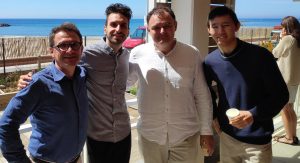Dr Michele Bernasconi from the Department for BioMedical Research (DBMR) at the University of Bern, discusses the potential for nanomedicine and immunotherapies to offer new ways to treat paediatric soft tissue sarcomas.
Rhabdomyosarcoma (RMS) is the most common childhood soft tissue sarcoma. Current therapies need to be improved in order to increase survival rates and decrease long-term side effects. We are currently following two approaches to devise novel RMS-targeted therapies: the development of targeted nanotherapeutics, and the development of chimeric antigen (CAR) T cell therapies.
Soft tissue sarcomas
Soft tissue sarcomas (STS) are a heterogeneous group of malignancies from mesoderm-derived cellular lineages. They can arise in connective tissue in different parts of the body. STS represent 6% of all malignancies in children and are the fourth most common group of cancers in patients younger than 16. In adults, they only make up 0.6% of all cancer cases.
Rhabdomyosarcoma
Approximately 50% of children and adolescents diagnosed with STS suffer from RMS, a striate-muscle lineage malignancy with variable pathological and clinical appearance. Although RMS can develop at any age, and 40% of the cases occur in adults, it is mainly associated with paediatric malignancies due to the incidence rate distribution. With approximately 4.5 cases per million individuals younger than 20, it is the most common STS in this population. In adults, only 3% of all STS patients are diagnosed with RMS but display instead a more aggressive form of the disease.
RMS is subdivided in two main histological groups, embryonal RMS (eRMS) and alveolar RMS (aRMS)1. eRMS arises in around 60-70% of all patients and has a rather good prognosis (70% five-year survival). In contrast, aRMS is the most aggressive subtype, characterised by a chromosomal translocation leading to the expression of a chimeric transcription factor PAX3/FOXO1, and has the poorest prognosis at diagnosis, with a five-year survival not exceeding 35%. Treatment response and prognosis vary widely depending on location and histology. Tumours can arise anywhere in the body except in bone, to which tumours can metastasise, among other sites.
RMS metastatic at diagnosis has a dismal five-year survival of 11.7%, and despite improvements recurring RMS are usually refractory to standard chemotherapy forcing the use of more aggressive therapies. The significant toxicity associated with current chemotherapies generates late effects, a major complication in paediatric oncology. Therefore, more effective and less toxic chemotherapies are needed for paediatric sarcomas.
Targeted therapies
The ideal therapy should target a specific feature of cancer, while sparing normal tissues. This has been initially achieved by using cytostatic drugs that would kill only highly proliferating cells. Unfortunately, especially in children, normal cells with a high proliferative rate can also be affected, which leads to unwanted long-lasting side effects. For this reason, the search for tumour-specific markers is one of the Holy Grails of modern cancer research.
In the research laboratory of the Department of Pediatric Hematology and Oncology of the Insel University Hospital in Bern, led by Professor Jochen Rössler and PD Dr Michele Bernasconi, we work on the identification of specific tumour targets expressed on the surface of RMS and on the development of novel targeted therapies for RMS. In particular, we focus on the development of targeted nanoparticles such as liposomes or porous silica nanoparticles, and on immunotherapies such as chimeric antigen receptor (CAR) T cells.
Nanomedicine
The encapsulation of therapeutic agents into nanoparticles has significant advantages over free drugs as it prolongs their circulation time and decreases toxic side effects. The first FDA approved nano-drug formulation for cancer treatment was Doxil, a Doxorubicin formulation in PEG-liposomes. The surface modification of nanoparticles with ligands can further enhance the interactions of the nanoparticles with the target cells and thus increase the cytotoxic activity of the chemotherapeutic agents.
We were able to achieve promising results in pre-clinical tests with RGD-functionalised liposomes encapsulating the anti-tumour compound Patupilone (EPO906)2, and RGD-functionalised Lipid-Protamine-siRNA (LPR) nanoparticles targeting PAX3/FOXO1.3 Vincristine-loaded liposomes showed enhanced tumour accumulation, but phage-display discovered peptides targeting the proprotein convertase furin, disappointingly, could not further increase tumour accumulation.4 Currently, Dzhangar Dzumashev, a PhD student in our lab, is working on the development of novel targeted VCR-loaded liposomes in a continuing collaboration with Professor Paola Luciani of the University of Bern.
In collaboration with Dr Frédérique Cunin and Dr Jean-Olivier Durand at the Institut Charles Gerhardt in Montpellier, we are devising new strategies to deliver chemotherapeutics and siRNA inhibitors to RMS with porous silica nanoparticles.
Surface targets identification
In order to identify novel optimal targets for drug delivery to RMS, Andrea Timpanaro, another PhD student in our lab, is characterising the surface protein expression of RMS by a combination of proteomics and genomics. By using mass spectrometry and databases for peptide alignment in collaboration with the Proteomics Facility of the DBMR, led by PD Dr Manfred Heller, we hope to be able to identify further specific targets for RMS.
One of the most promising targets expressed on the surface of RMS cells so far is the Fibroblast Growth Factor Receptor 4 (FGFR4), originally identified by Dr Javed Khan, now Deputy Chief of the Genetics Branch of the NCI.
Fibroblast Growth Factor Receptor 4
FGFR4 belongs to the family of receptor tyrosine kinases and is involved in myogenesis and muscle regeneration by promoting cell survival and differentiation. FGFR4 is absent in normal differentiated muscles and its expression is limited to distinct tissues. FGFR4, therefore, represents a promising candidate for targeted therapies in RMS.
During her thesis in our lab, Dr Nadjie Alijaj was able to identify and characterise several nanobodies with high specificity for FGFR4, in collaboration with Dr Franck Perez and Dr Sandrine Mouttel of the Institut Curie in Paris. Preliminary in vitro results indicate that these nanobodies can very efficiently target liposomes to RMS cells. A European Patent Application number EP20305535 entitled ‘Single domain antibodies and their use in cancer therapies’ was filed to protect the commercial use of these nanobodies.
Immunotherapies
CAR T cells are engineered T cells expressing fusion proteins composed of an extracellular antigen binding moiety recognising tumour surface antigens; a transmembrane domain; and an intracellular effector domain.5 CAR T cells have shown considerable success in the treatment of haematological malignancies. The CD19 targeted CAR T cell for Acute Lymphoblastic Leukemia is the first treatment that has been approved for paediatric use. However, the use of CAR T cells for paediatric solid tumours is challenging on several fronts. Epitopes for targeting are largely unknown for many paediatric solid tumours. The most advanced in clinical trials are GD2-CAR T cells for neuroblastoma (reviewed in6). For RMS, some targets have been tested pre-clinically, and the most promising results have been achieved with HER2 CAR T cells.7 With the targets discovered by the sufaceome profiling of RMS cells, Andrea Timpanaro is now developing novel CAR T cells for RMS, with some very promising preliminary results.
Prospectives
The development of targeted therapies for paediatric sarcomas is our priority in order to improve existing therapies and reduce long-term side effects. With the current projects, we want to take our commitment a step closer to clinical application. In particular, nanobodies targeting FGFR4 represent a very promising tool to develop RMS-targeted nanoparticles and CAR T cells.
References
- Skapek, S. X. et al. ‘Rhabdomyosarcoma’. Nat Rev Dis Primers 5, 1, doi:10.1038/s41572-018-0051-2 (2019)
- Scherzinger-Laude, K. et al. ‘Treatment of neuroblastoma and rhabdomyosarcoma using RGD-modified liposomal formulations of patupilone (EPO906)’. Int J Nanomedicine 8, 2197-2211, doi:10.2147/IJN.S44025 (2012)
- Rengaswamy, V., Zimmer, D., Süss, R. & Rössler, J. ‘RGD liposome-protamine-siRNA (LPR) nanoparticles targeting PAX3-FOXO1 for alveolar rhabdomyosarcoma therapy’. J. Control. Release 235, 319-327, doi:10.1016/j.jconrel.2016.05.063 (2016)
- Roveri, M. et al. ‘Prolonged circulation and increased tumor accumulation of liposomal vincristine in a mouse model of rhabdomyosarcoma’. Nanomedicine (Lond) 12, 1135-1151, doi:10.2217/nnm-2017-0430 (2017)
- June, C. H. & Sadelain, M. ‘Chimeric Antigen Receptor Therapy’. N Engl J Med 379, 64-73, doi:10.1056/nejmra1706169 (2018)
- Bernasconi, M., Dzhumashev, D., Timpanaro, A. & Rössler, J. ‘Targeted therapies for rhabdomyosarcoma’. Schweizer Krebsbulletin 39, 129-133 https://tinyurl.com/yyjuu5b8 (2019)
- Hegde, M. et al. ‘Tumor response and endogenous immune reactivity after administration of HER2 CAR T cells in a child with metastatic rhabdomyosarcoma’. Nat Commun 11, 3549, doi:10.1038/s41467-020-17175-8 (2020)
Dr Michele Bernasconi
Pediatric Hematology & Oncology Research, Inselspital University Hospital Bern
Department for BioMedical Research (DBMR), University of Bern
+41 31 63 2 95 21
michele.bernasconi@dbmr.unibe.ch
www.tumortargeting.ch
www.kinderkrebs-bern.ch
Please note, this article will also appear in the fourth edition of our new quarterly publication.










